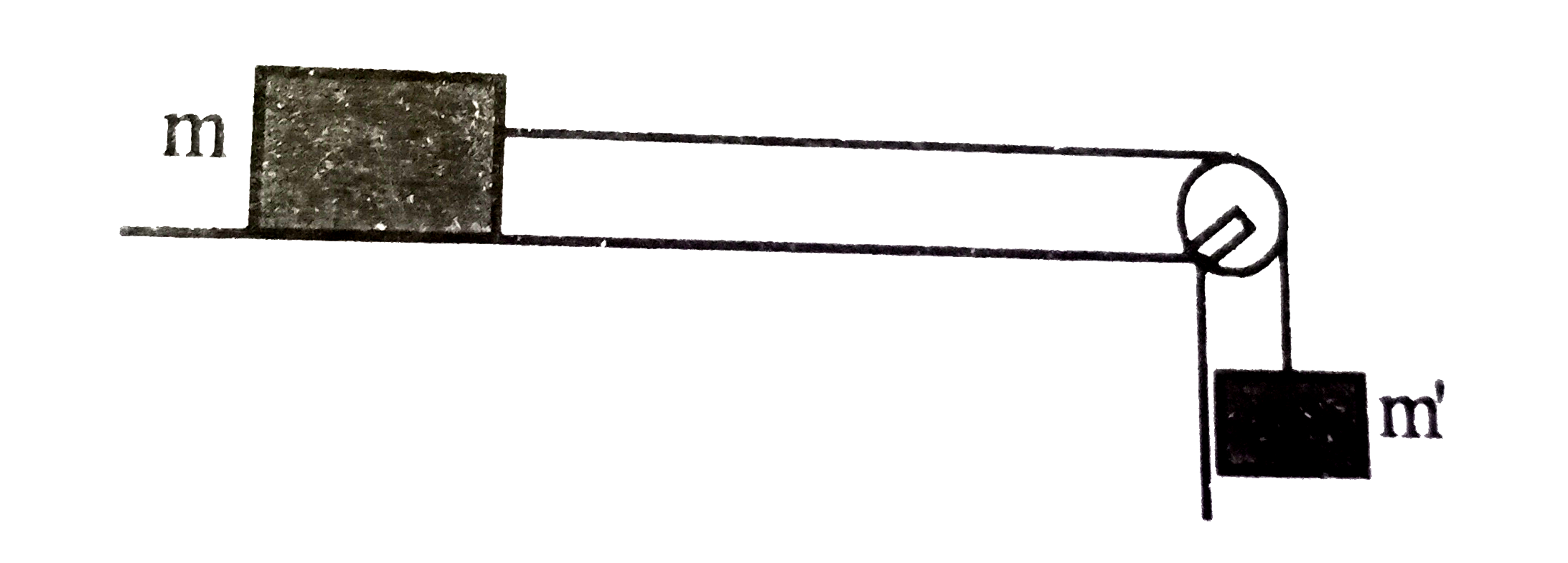Two masses m and m' are tied with a thread passing over a pulley, m' is on a frictionless horizontal surface and m is hanging freely. If acceleration due to gravity is g, the acceleration of m' in this arrangment will be :
g
mg/(m+m')
mg/m'
mg/(m−m')
The correct Answer is:2
To solve the problem, we will analyze the forces acting on the two masses and apply Newton's second law of motion.
1. Identify the System: We have two masses, m (hanging mass) and m′ (mass on the horizontal surface). The mass m′ is on a frictionless surface, and m is hanging freely.
2. Determine the Forces: The only force acting on the hanging mass m is its weight, which is given by F=mg, where g is the acceleration due to gravity.
3. Apply Newton's Second Law: According to Newton's second law, the net force acting on an object is equal to the mass of the object multiplied by its acceleration (F=ma).
4. Calculate the Net Force: The net force acting on the system is the weight of the hanging mass m, which causes both masses to accelerate. Thus, the net force Fnet=mg.
5. Total Mass of the System: The total mass being accelerated is the sum of both masses, which is m+m′.
6. Set Up the Equation for Acceleration: Using the formula for acceleration a=Fnetmtotal, we can substitute the values:
a=mgm+m′
7. Final Expression for Acceleration: Therefore, the acceleration of mass m′ (and also mass m since they are connected) is given by:
a=mgm+m′
Final Answer:
The acceleration of mass m′ is mgm+m′.
a=mgm+m′
a=mgm+m′
The acceleration of mass m′ is mgm+m′.
Topper's Solved these Questions
- LAWS OF MOTION BOOK - VMC MODULES ENGLISHCHAPTER - LAWS OF MOTION EXERCISE - IMPECCABLE
53 Videos
- LAWS OF MOTION BOOK - VMC MODULES ENGLISHCHAPTER - LAWS OF MOTION EXERCISE - ENABLE
50 Videos
- KINEMATICS OF A PARTICLE BOOK - VMC MODULES ENGLISHCHAPTER - KINEMATICS OF A PARTICLE EXERCISE - JEE Advanced (archive)
14 Videos
- LIQUIDSBOOK - VMC MODULES ENGLISHCHAPTER - LIQUIDSEXERCISE - JEE ADVANCED (LEVEL -2)
55 Videos
Similar Questions
Coefficient of kinetic friction and coefficient of static friction between two blocks is μk and μs respectively. In general
View SolutionA body A mass m1 exerts a force on another body B of mass m2 . If the acceleration of B be a2 , then the acceleration (in magnitude) of A is
View SolutionA ship of mass 3×107kg initaily at rest , is pulley by a force of 5×104N a distanceof 3m. Assuming that the resistence dua to water negligible the speed of the ship is .
View SolutionA vessel containing water is given a constant acceleration a towards the right,a straight horizontal path. Which of the following diagram represents the surface of the liquid.
View SolutionTwo masses m and m (m>m) are connected by massless flexible and inextensible string passed over massless and frictionless pulley. The acceleration of centre of mass is
View SolutionAcceleration due to gravity ' g ' for a body of mass ' m ' on earth's surface is proportional to (Radius of earth= R , mass of earth= M
View SolutionIn the figure given below masses m and m' are tied with a thread passing over a pulley, m' is on a frictionlesss horizontal surface. If acceleration due to gravity is g, the acceleration of m' in this arrangement will be

View SolutionTwo particles of masses m and M(Mgtm) are connected by a cord that passes over a massless, frictionless pulley. The tension T in the string and the acceleration a of the particles is
View SolutionIn the fig. given masses m and m' are tied with a tread passing over a pulley, m' is on a frictionless horizontal surface. If acceleration due to gravity is g, the acceleration of m' in this arrangement will be:-

View SolutionA block of mass M is placed on a horizontal surface. It is tied with an inextensible string that passes through ideal pulleys. A mass m is connected to the pulley as shown. For what value of m, the block M will accelerate towards the fixed pulley ?
View SolutionFigure shows two blocks of mass m and m connected by a string passing over a pulley. The horizontal table over which the mass m slides is smooth. The pulley (uniform disc) has mass m and it can freely rotate about this axis. Find the acceleration of the mass m assuming that the string does not slip on the pulley.
View SolutionTwo masses m and m' are tied with a thread passing over a pulley, m' is on a frictionless horizontal surface and m is hanging freely. If acceleration due to gravity is g, the acceleration of m' in this arrangment will be :
View Solutionm1=m/2 किग्रा तथा m2=m किग्रा के दो द्रव्यमान धागे से बाँधकर हल्की घर्षणरहित घिरनी के ऊपर लटके हैं। द्रव्यमानों का त्वरण क्या होगा जाव वे गति करने के लिये स्वतन्त्र हैं ? (g=9.8 मी /से2 )

View SolutionTwo masses M and m are connected at the two ends of an inextensible string. The string passes over a smooth frictionless pulley. Calculate the acceleration of the masses . Given M > m.
View SolutionTwo masses, m and 2m are connected by a string that passes over a frictionless pulley. When the mass 2m is released, acceleration of the mass m upwards, will be
View Solution

